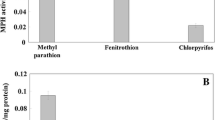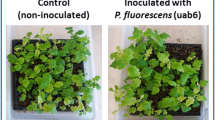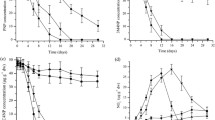Abstract
A multifunctional Pseudomonas putida X3 strain was successfully engineered by introducing methyl parathion (MP)-degrading gene and enhanced green fluorescent protein (EGFP) gene in P. putida X4 (CCTCC: 209319). In liquid cultures, the engineered X3 strain utilized MP as sole carbon source for growth and degraded 100 mg L−1 of MP within 24 h; however, this strain did not further metabolize p-nitrophenol (PNP), an intermediate metabolite of MP. No discrepancy in minimum inhibitory concentrations (MICs) to cadmium (Cd), copper (Cu), zinc (Zn), and cobalt (Co) was observed between the engineered X3 strain and its host strain. The inoculated X3 strain accelerated MP degradation in different polluted soil microcosms with 100 mg MP kg−1 dry soil and/or 5 mg Cd kg−1 dry soil; MP was completely eliminated within 40 h. However, the presence of Cd in the early stage of remediation slightly delayed MP degradation. The application of X3 strain in Cd-contaminated soil strongly affected the distribution of Cd fractions and immobilized Cd by reducing bioavailable Cd concentrations with lower soluble/exchangeable Cd and organic-bound Cd. The inoculated X3 strain also colonized and proliferated in various contaminated microcosms. Our results suggested that the engineered X3 strain is a potential bioremediation agent showing competitive advantage in complex contaminated environments.





Similar content being viewed by others
References
Ardestani M, van Gestel CAM (2013) Using a toxicokinetics approach to explain the effect of soil pH on cadmium bioavailability to Folsomia candida. Environ Pollut 180:122–130
Ayano H, Miyake M, Terasawa K, Kuroda M, Soda S, Sakaguchi T, Ike M (2014) Isolation of a selenite-reducing and cadmium-resistant bacterium Pseudomonas sp. strain RB for microbial synthesis of CdSe nanoparticles. J Biosci Bioeng 117(5):576–581
Cassidy MB, Leung KT, Lee H, Trevors JT (2000) A comparison of enumeration methods for culturable Pseudomonas fluorescens cells marked with green fluorescent protein. J Microbiol Meth 40(2):135–145
Cormack BP, Valdivia RH, Falkow S (1996) FACS-optimized mutants of the green fluorescent protein (GFP). Gene 173(1):33–38
Cui Z, Li S, Fu G (2001) Isolation of methyl parathion-degrading strain M6 and cloning of the methyl parathion hydrolase gene. Appl Environ Microbiol 67(10):4922–4925
Dong D, Yan A, Liu H, Zhang X, Xu Y (2006) Removal of humic substances from soil DNA using aluminium sulfate. J Microbiol Meth 66:217–222
El-Helow ER, Sabry SA, Amer RM (2000) Cadmium biosorption by a cadmium resistant strain of Bacillus thuringiensis: regulation and optimization of cell surface affinity for metal cations. Biometals 13:273–280
Elvang AM, Westerberg K, Jernberg C (2001) Use of green fluorencent protein and luciferase biomarkers to monitor survival and activity of Arthrobacter chlorophenolicus A6 cells during degradation of 4-chlorophenol in soil. Environ Microbiol 3(1):32–42
Fu Y, Chen W, Huang Q (2008) Construction of two lux-tagged Hg2 + -specific biosensors and their luminescence performance. Appl Microbiol Biotechnol 79:363–370
Hassan J, Farahani A, Shamsipur M, Damerchili F (2010) Rapid and simple low density miniaturized homogeneous liquid–liquid extraction and gas chromatography/mass spectrometric determination of pesticide residues in sediment. J Hazard Mater 184(1):869–871
He X, Chen W, Huang Q (2012) Surface display of monkey metallothionein α tandem repeats and EGFP fusion protein on Pseudomonas putida X4 for biosorption and detection of cadmium. Appl Microbiol Biotechnol 95:1605–1613
Hornel I, Sutherland TD, Harcourt RL, Russell RJ, Oakeshott JG (2002) Identification of an opd (Organophosphate Degradation) Gene in an Agrobacterium Isolate. Appl Environ Microbiol 68(7):3371–3376
Jiang C, Sun H, Sun T, Zhang Q, Zhang Y (2009) Immobilization of cadmium in soils by UV-mutated Bacillus subtilis 38 bioaugmentation and NovoGro amendment. J Hazard Mater 167:1170–1177
Lei Y, Mulchandani A, Chen W (2005) Improved degradation of organophosphorus nerve agents and p-nitrophenol by Pseudomonas putida JS444 with surface-expressed organophosphorus hydrolase. Biotechnol Prog 21(3):678–681
Li X, He J, Li S (2007) Isolation of a chlorpyrifos-degrading bacterium, sphingomonas sp. strain Dsp-2, and cloning of the mpd gene. Res Microbiol 158:143–149
Ramanathan MP, Lalithakumari D (1999) Complete mineralization of methylparathion by Pseudomonas sp. A3. Appl Biochem Biotechnol 80(1):1–12
Rani A, Souche YS, Goel R (2009) Comparative assessment of in situ bioremediation potential of cadmium resistant acidophilic Pseudomonas putida 62BN and alkalophilic pseudomonas monteilli 97AN strains on soybean. Int Biodeterior Biodegrad 63:62–66
Sambrook J, Russell D (2001) Molecular Cloning: A Laboratory Manual, 3rd ed
Shen YJ, Lu P, Mei H, Yu HJ, Hong Q, Li SP (2010) Isolation of a methyl parathion-degrading strain Stenotrophomonas sp. SMSP-1 and cloning of the ophc2 gene. Biogegradation 21(5):785–792
Shimazu M, Mulchandani A, Chen W (2001) Simultaneous degradation of organophosphorus pesticides and p-nitrophenol by a genetically engineered Moraxella sp. with surface-expressed organophosphorus hydrolase. Biotechnol Bioeng 76(4):318–324
Siddavattam D, Khajamohiddin S, Manavathi B, Pakala SB, Merrick M (2003) Transposon-like organization of the plasmid-borne organophosphate degradation (opd) gene cluster found in Flavobacterium sp. Appl Environ Microbiol 69(5):2533–2539
Singh S, Kang SH, Mulchandani A, Chen W (2008) Bioremediation: environmental clean-up through pathway engineering. Curr Opin Biotechnol 19(5):437–444
Sinha S, Mukherjee SK (2008) Cadmium-induced siderophore production by a high Cd-resistant bacterial strain relieved Cd toxicity in plants through root colonization. Cur Microbiol 56:55–60
Sposito G, Lund LJ, Chang AC (1982) Trace metal chemistry in arid-zone field soils amended with sewage sludge: I. Fractionation of Ni, Cu, Zn, Cd, and Pb in solid phases. Soil Sci Soci Amer J 46:260–264
Szpirer CY, Faelen M, Couturier M (2001) Mobilization function of the pBHR1 plasmid, a derivative of the broad-host-range plasmid pBBR1. J Bacteriol 183(6):2101–2110
Timmis KN, Steffan RJ, Untermann R (1994) Designing microorganisms for the treatment of toxic wastes. Annu Rev Microbiol 48:525–557
Tiwari MK, Guha S (2013) Kinetics of biotransformation of chlorpyrifos in aqueous and soil slurry environments. Water Res 51:73–85
Tsatsakis AM, Tsakiris IN, Maxaira K, Christakis-Hampsas M, Tzanakakis-Nikitovich DP, Niklis N (2002) Assessment of safe harvesting after methyl parathion application in peaches. Bull Environ Contam Toxicol 68(6):824–830
Valls M, Atrian S, de Lorenzo V, Fernández LA (2000) Engineering a mouse metallothionein on the cell surface of Ralstonia eutropha CH34 for immobilization of heavy metals in soil. Nat Biotechnol 18:661–665
Wang J, Chen C (2009) Biosorbents for heavy metals removal and their future. Biotechnol Adv 27(2):195–226
Wang GJ, Gentry TJ, Grass G, Josephson K, Rensing C, Pepper I (2004) Real-time PCR quantification of a green fluorescent protein-labeled, genetically engineered Pseudomonas putida strain during 2-chlorobenzoate degradation in soil. FEMS Microbiol Lett 233:307–314
Wei X, Fang L, Cai P, Huang Q, Chen H, Liang W, Rong X (2011) Influence of extracellular polymeric substances (EPS) on Cd adsorption by bacteria. Environ Pollut 159:1369–1374
Wu CH, Mulchandani A, Chen W (2008) Versatile microbial surface-display for environmental remediation and biofuels production. Trends Microbiol 16(4):181–188
Xu X, Huang Q, Huang Q, Chen W (2012) Soil microbial augmentation by an EGFP-tagged Pseudomonas putida X4 to reduce phytoavailable cadmium. Int Biodeterior Biodegrad 71:55–60
Yang C, Cai N, Dong M, Jiang H, Li J, Qiao C, Mulchandani A, Chen W (2008) Surface display of MPH on Pseudomonas putida JS 4444 using ice nucleation protein and its application in detoxification of organophosphate. Biotechnol Bioeng 99(1):30–37
Zafar MN, Nadeem R, Hanif MA (2007) Biosorption of nickel from protonated rice bran. J Hazard Mater 143:478–485
Zhang R, Cui Z, Zhang X, Jiang J, Gu JD, Li S (2006) Cloning of the organophosphorus pesticide hydrolase gene clusters of seven degradative bacteria isolated from a methyl parathion contaminated site and evidence of their horizontal gene transfer. Biodegradation 17(5):465–472
Zhang J, Xin Y, Liu H, Wang S, Zhou N (2008) Metabolism-independent chemotaxis of Pseudomonas sp. strain WBC-3 toward aromatic compounds. J Environ Sci 20(10):1238–1242
Acknowledgments
The research was financially supported by the National Natural Science Foundation of China (41230854, 31300102), the National High Technology Research and Development Program of China (“863” Program, 2012AA101402), the Program for Changjiang Scholars and Innovative Research Team in University of China (IRT1247), and the Fundamental Research Funds for the Central Universities (2662015PY016, 2662015PY116).
Author information
Authors and Affiliations
Corresponding authors
Ethics declarations
This article does not contain any studies with animals performed by any of the authors. All authors have read and approved the final manuscript.
Conflict of interest
The authors declare that they have no competing interests.
Additional information
Rong Zhang and Xingjian Xu contributed equally to this work.
Electronic supplementary material
Below is the link to the electronic supplementary material.
ESM 1
(PDF 341 kb)
Rights and permissions
About this article
Cite this article
Zhang, R., Xu, X., Chen, W. et al. Genetically engineered Pseudomonas putida X3 strain and its potential ability to bioremediate soil microcosms contaminated with methyl parathion and cadmium. Appl Microbiol Biotechnol 100, 1987–1997 (2016). https://doi.org/10.1007/s00253-015-7099-7
Received:
Revised:
Accepted:
Published:
Issue Date:
DOI: https://doi.org/10.1007/s00253-015-7099-7




